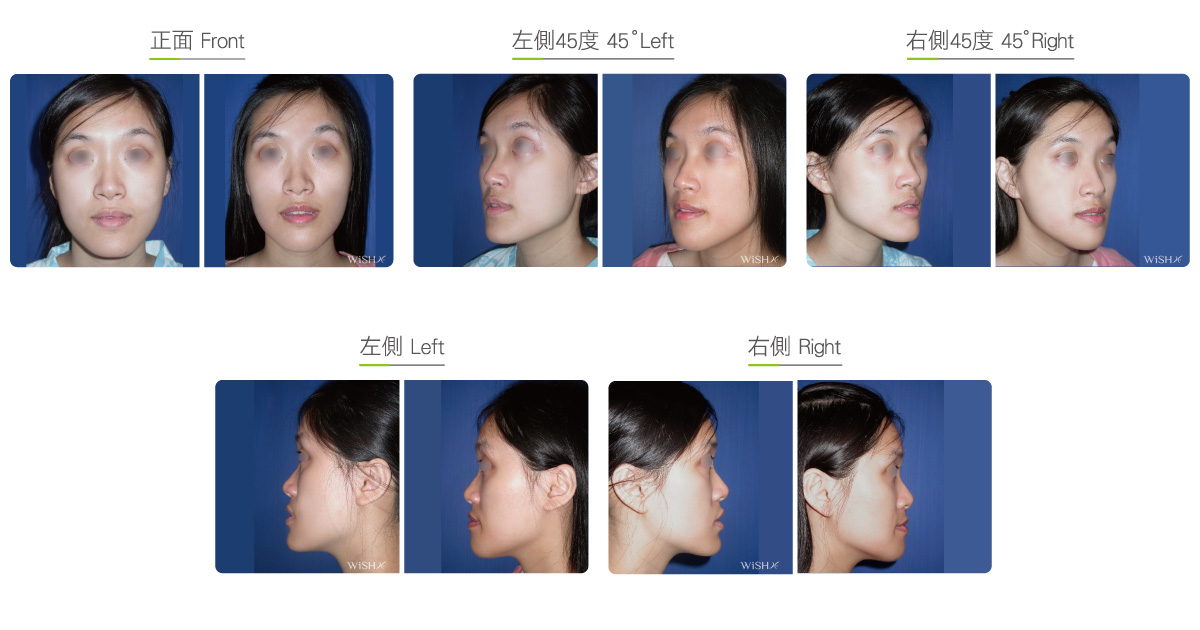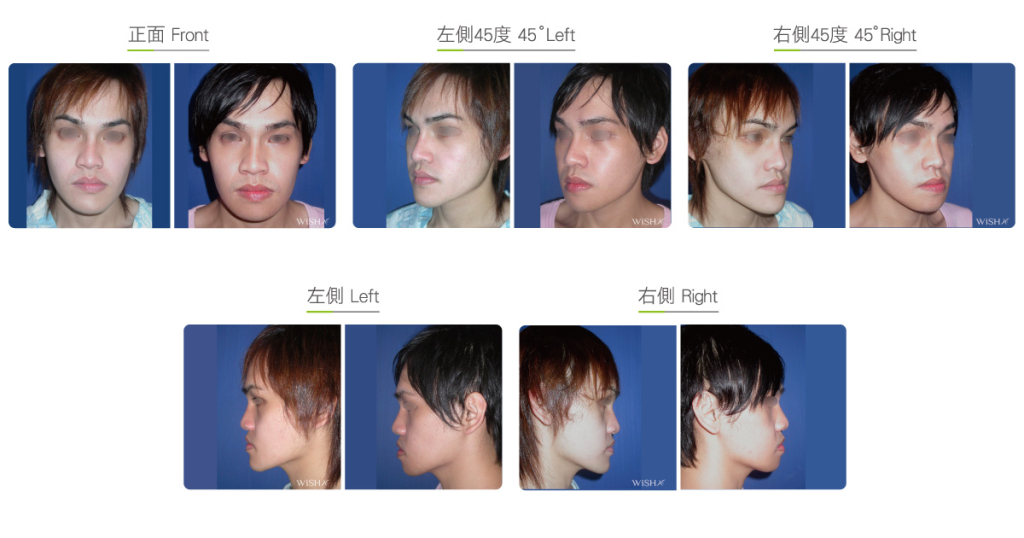Posterior Sliding Genioplasty
This procedure is also called “chin shortening surgery” or “reduction genioplasty;” the main goal is to correct the lantern long chin (“bailing bucket”-shaped chin) or forward protrusive chin. The facial contours of these patients in the side view often show not only a disproportional overdeveloped chin or combined depressed midfaces (maxillary hypoplasia) but also overdeveloped mandibles, making jawlines very steep and long (mandibular prognathism). Thus, the “upper depressed–lower protruded” condition results in a typical “crescent-shaped” or “curved knife-shaped” face; several patients with these conditions can also have teeth function problems such as malocclusion or misalignment. Accordingly, surgeons will have to clarify the requirements of patients during preoperative evaluation. If patients only want to improve their undesired face shape, chinbone segmental resection with posterior sliding surgery should be proper for correcting their problem by shortening and backward sliding of the chinbone; however, if patients also want to correct their malocclusion at the same time, they will have to consider extensive two-jaw surgery or prognathic surgery to simultaneously obtain the dual results of facial contour reconstruction and malocclusion correction.
The procedure is very similar to that of chinbone anterior sliding osteotomy and necessitates the same incision in the lower gum. However, in patients undergoing correction for the bailing bucket-shaped chins, the chin bones are mostly obviously overdeveloped. Thus, Dr. Chuang will have to transversely cut through the chinbone right under the mental nerve and remove a segment of it (segmental resection). The thickness of the removed bone will vary depending on the individual situation, and the average reducible distance is approximately 0.8–1 cm. After removing the bone, Dr. Chuang will push the distal section upward or backward and fix it on the main body with steel wires, bone screws, or plates; finally, he will finish the entire procedure after confirming that the central part of the chin is in the correct position. This procedure can reduce the length of the chin in the front view and retract and shorten the jawline in the side view. If necessary, Dr. Chuang will flexibly combine this surgery with either mandible reduction or V-line chin reduction to not only reduce the protrusive or elongated chin but also achieve the perfect small and pointed contour for the lower face. For patients with a congenital depressed midface (maxillary hypoplasia), Dr. Chuang will simultaneously perform paranasal or submalar triangle implants to balance the facial ratio between the midface and chin; thus, the facial deficiencies such as “curved knife face” or “horse face” can be effectively improved in these combined procedures.
Surgical conditions
Duration
- Type of anesthesia: General anesthesia
- Type of incision: Intraoral lower gum (5–8 cm)
- Recovery: 7–10 days
- Removal of stitches: None
General instructions
No food and water on the day of surgery
- Only a soft or fluid diet should be consumed for 1 week postoperatively.
- Extensive opening of mouth or consumption of very hard food and fruits should be avoided for 1 month postoperatively.
- Force on the face or squeezing of the face should be avoided for 3 months postoperatively.
- A warm towel should be applied on the chin every day to help sensitivity recovery within 6 months postoperatively.
Ideal candidates
- Those whose faces look like a “curved knife” or “bailing bucket” in the side view due to a long or protrusive chin.
- Those whose lower face ratios are not proportional due to excessively long and fleshy chins in the front view.
- Those with normal teeth occlusion but strong or long chins.
- Those who only want to improve their long chin problems but not correct their teeth malocclusion.
- Those who are unwilling to undergo prognathic surgery due to its high risks.
Potential complications
- Temporary chin numbness
- Mouth shape or expression change
- Chin skin loosening
- Fleshy or extra lower lips
- Incomplete correction
Surgical advantages
-
Will simply improve the chin contour with a minimal surgical injury.
-
Will not affect teeth occlusion, with the surgical risk much lower than that associated with prognathic surgery.
-
Will be combined with V-line chin reduction to achieve the dual results of making the chin shorter and smaller.
-
Will improve the condition of undesirable midface depression due to an excessively long chin.
Surgical drawbacks
-
Chin skin can be loosened due to chinbone retraction.
-
The lower lip or chin can have temporary numbness.
-
Only improves the lower face contour but does not provide functional correction of teeth malocclusion as done by prognathic surgery.
-
Will not simultaneously improve the condition of a depressed upper jaw as done by a two-jaw surgery or prognathic surgery.
-
Will only improve the condition of severe a “bailing bucket-shaped chin”.
Possible procedures in conjunction
Comparison Of Posterior Sliding Genioplasty And Prognathic Surgery
| Posterior sliding genioplasty | Prognathic surgery | |
|---|---|---|
| Ideal candidates | Esthetic correction for long chin or “bailing bucket”- shaped chin problems | Correction for long chin and teeth malocclusion (overbite occlusion) at the same time |
| Rang of procedure | Chinbone and mandible | Chinbone, mandible, and maxillary bones |
| Procedure duration (h) | 1.5~2 | 4~6 |
| Postoperative recovery period (weeks) | 1~2 | >4 |
| Functional improvement | No | Yes |
| Teeth correction | No | Yes |
| Surgical risk | Low | High |
| Skin loosening | Around the chin area | Middle and lower face |
| Nerve numbness | Temporary | May be permanent |
| Reversibility | Yes | No |
| Hospitalization | None | Must |
| Surgery cost | Low | High |




